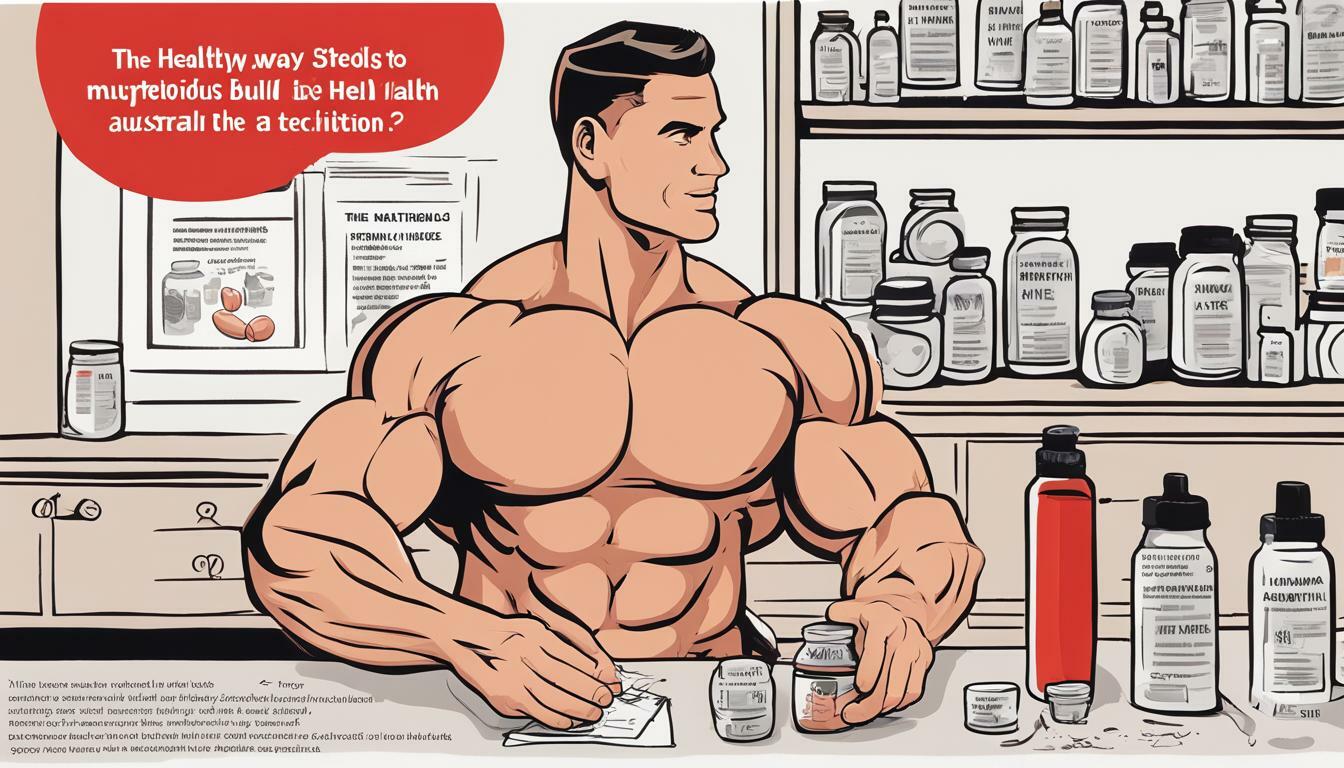How to Prevent Gyno on Steroids: Australian Health Guide
For anyone considering using steroids, it’s important to be aware of the potential side effects, one of which is gyno or gynecomastia. This condition involves the development of breast tissue in men due to increased estrogen levels.
Fortunately, there are steps you can take to prevent gyno while using steroids. By taking proactive measures, you can minimize the risk of developing this condition and maintain overall health and wellbeing during your steroid cycle.
Key Takeaways:
- Gyno is a potential side effect of steroid use and involves the development of breast tissue in men due to increased estrogen levels.
- Preventative measures can minimize the risk of developing gyno while using steroids.
Understanding Gyno and Steroids
Gynecomastia, commonly known as gyno, is a condition characterized by the enlargement of breast tissue in males. While gyno can occur naturally due to hormonal imbalances, it can also be induced by the use of anabolic steroids.
Steroids can increase estrogen levels in the body, leading to the development of gyno. Estrogen, also known as the female hormone, is responsible for breast development and can cause breast tissue to grow in men.
It is important to note that not all steroids carry the same risk for gyno. Certain steroids, such as testosterone and dianabol, have a higher likelihood of causing gyno due to their conversion to estrogen. On the other hand, steroids like trenbolone have a lower risk since they do not convert to estrogen.
Avoid Developing Gyno While on Steroids
To avoid developing gyno while on steroids, it is important to be aware of the potential risk and take preventative measures. This includes regularly monitoring for signs of gyno, such as nipple tenderness or swelling, and taking action at the first sign of symptoms.
Other preventative measures include implementing an aromatase inhibitor to manage estrogen levels, engaging in regular cardiovascular exercise to promote hormone balance, and adjusting steroid dosages as needed. It is also important to work with a healthcare professional or trusted coach to ensure safe and responsible steroid use.
By taking proactive measures, individuals can minimize the risk of developing gyno while still achieving their desired performance-enhancing results.
Gyno Prevention Techniques
Preventing gyno while using steroids requires a multi-faceted approach that includes implementing various techniques to maintain hormonal balance. Here are some expert tips to avoid developing gyno during a steroid cycle:
- Manage Estrogen Levels: High estrogen levels can lead to gyno. It is important to keep estrogen levels under control by incorporating an aromatase inhibitor, such as Arimidex or Aromasin, into your steroid cycle. These inhibitors can reduce the conversion of testosterone to estrogen, preventing gyno.
- Engage in Regular Cardiovascular Exercise: Cardiovascular exercise can promote overall hormonal balance, helping to prevent gyno. Aim for at least 30 minutes of cardiovascular exercise three to four times per week.
- Consider Using Selective Estrogen Receptor Modulators (SERMs): SERMs, such as Tamoxifen or Clomid, can help block estrogen receptors and prevent gyno. These medications are commonly used during post-cycle therapy, but may also be recommended by a healthcare professional during a steroid cycle to manage estrogen levels.
- Use Quality Steroids: Opt for high-quality, pharmaceutical-grade steroids from a reputable source to minimize the risk of developing gyno.
- Monitor for Early Signs of Gyno: Regularly check for any signs of gyno, such as swelling or tenderness in the chest area. If you notice any early signs, address them immediately with a healthcare professional or trusted coach to prevent the condition from progressing.
By implementing these gyno prevention techniques, you can reduce your risk of developing gyno during a steroid cycle. Working with a healthcare professional or experienced coach can also provide valuable support and guidance throughout the process.
Diet and Nutrition for Gyno Prevention
In addition to implementing preventative techniques during a steroid cycle, paying attention to diet and nutrition can also help minimize the risk of developing gyno.
Zinc is an essential mineral for regulating estrogen levels and supporting hormonal balance. Including zinc-rich foods in your diet, such as oysters, beef, and pumpkin seeds, can help prevent gyno. Other nutrients to focus on include Vitamin D, which is important for overall health and can improve testosterone levels, and Omega-3 fatty acids, which have been linked to reducing inflammation and promoting hormonal balance.
Avoiding processed and high-sugar foods can also be beneficial in preventing gyno. These types of foods can lead to inflammation and imbalanced hormone levels, potentially increasing the risk of developing gyno while on a steroid cycle. Incorporating plenty of fruits, vegetables, lean protein, and healthy fats can help support overall hormonal balance and minimize the risk of developing gyno.
Sample Diet for Gyno Prevention:
| Meal | Food |
|---|---|
| Breakfast | Two eggs, spinach, tomato, whole-grain toast |
| Snack | Plain Greek yogurt, blueberries, almonds |
| Lunch | Grilled chicken or fish, mixed greens, avocado, quinoa |
| Snack | Celery sticks with almond butter |
| Dinner | Lean beef or tofu stir-fry with vegetables, brown rice |
By implementing a balanced diet and paying attention to key nutrients, you can support overall hormonal balance and minimize the risk of developing gyno while on a steroid cycle. Additionally, working with a healthcare professional or qualified coach can help ensure that your diet is tailored to your specific needs and goals.
Training Strategies to Reduce Gyno Risk
While it may not be possible to completely eliminate the risk of gyno while using steroids, there are steps you can take to minimize the likelihood of developing this condition. Here are some steroid-induced gynecomastia prevention techniques you can implement through your training regimen:
- Incorporate compound exercises: Compound exercises such as bench presses, push-ups, and chest flies are effective for targeting the chest muscles while also engaging other muscle groups. This can help maintain muscle balance and prevent the development of gyno.
- Target chest muscles: Focus on exercises that target the chest muscles, such as incline or decline bench presses and cable crossovers. By developing these muscles proportionately, you can reduce the risk of gyno.
- Implement progressive overload: Gradually increasing weight and intensity over time can help you maintain muscle balance and prevent the development of gyno. Avoid sudden increases in weight or intensity, as this can lead to muscle imbalances and increase the risk of gyno.
By incorporating these steps into your training routine, you can help minimize the risk of gyno while using performance-enhancing drugs. Remember to listen to your body and adjust your training regimen as needed to maintain muscle balance and promote overall health.
Monitoring and Adjusting Steroid Dosages
To prevent the development of gyno while using steroids, it’s essential to monitor and adjust steroid dosages regularly. This process requires careful observation of physical and emotional changes that may indicate an imbalance in hormone levels.
If you’re working with a healthcare professional or a trusted coach, they can help you determine the appropriate dosage for your goals and body type. However, it’s still crucial to stay vigilant of any potential signs of gyno, such as breast tenderness or swelling.
Steps to Prevent Gyno on Steroid Use
There are several steps you can take to prevent gyno while using steroids:
- Start with a low dosage and gradually increase it based on your response.
- Use an aromatase inhibitor to regulate estrogen levels.
- Engage in regular cardiovascular exercise to promote overall hormonal balance.
Ways to Minimize Gyno Risk on Steroid Cycle
In addition to the above steps, you can minimize the risk of gyno by:
- Monitoring yourself closely for any potential signs of gyno, such as breast tenderness or swelling.
- Working closely with a healthcare professional or a trusted coach to ensure the dosages are appropriate for your needs and goals.
Post-Cycle Therapy for Gyno Prevention
Post-cycle therapy (PCT) is a crucial step in preventing gyno while using steroids. The purpose of PCT is to help restore the body’s natural hormone balance after a steroid cycle, minimizing the risk of estrogen-related side effects such as gyno.
One common strategy for PCT is the use of selective estrogen receptor modulators (SERMs), such as tamoxifen or clomiphene citrate. These drugs work by blocking the effects of estrogen on breast tissue, helping to prevent the development of gyno.
In addition to using SERMs, it is important to gradually taper off steroid use during PCT. Abruptly stopping steroids can cause hormonal imbalances and potentially lead to gyno. Consulting with a healthcare professional or coach can help ensure that the PCT plan is appropriate for the individual’s needs.
Overall, implementing a comprehensive PCT plan is an essential step in preventing gyno while using steroids. By helping to restore the body’s natural hormonal balance, individuals can minimize the risk of developing gyno and other estrogen-related side effects.
Conclusion
Preventing gyno while using steroids requires a proactive approach. Understanding the risks and implementing practical strategies to manage estrogen levels and promote overall hormonal balance is critical to avoiding gyno. Monitoring and adjusting steroid dosages, maintaining a healthy diet, and engaging in targeted training strategies can help reduce the risk of gyno.
It is important to consult with healthcare professionals or trusted coaches throughout the process to ensure dosages and strategies are appropriate and to address any potential signs of gyno early on. Post-cycle therapy using selective estrogen receptor modulators (SERMs) is also an effective technique for preventing gyno.
Takeaway:
By following the techniques and strategies outlined in this guide, you can reduce the risk of developing gyno while using steroids. Stay informed, stay proactive, and focus on maintaining overall hormonal balance to achieve your performance goals safely and effectively.







